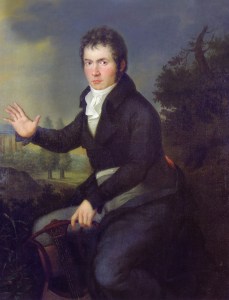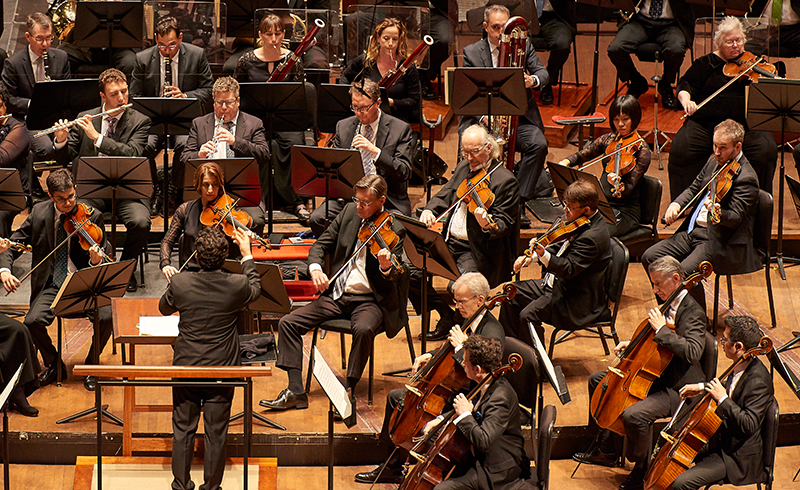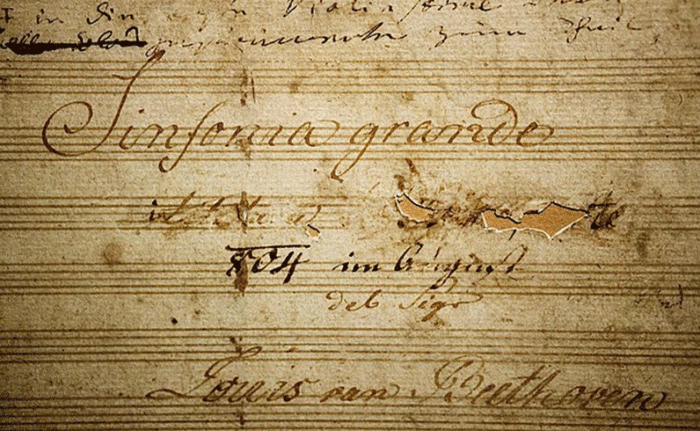The Houston Symphony begins its highly anticipated 2021–22 Season with a blazing crescendo, featuring Beethoven’s immortal Fifth Symphony. This concert also includes the return of Andrés Orozco-Estrada, marking his first performance with the Symphony since the pandemic and his final season as Music Director. Read about the man behind the music and the structure of the legendary composition, and purchase tickets for this can’t-miss performance at this link.

There are few individuals who truly change the course of history. Ludwig van Beethoven (1770-1827) is one of those individuals. There is music before Beethoven and music after Beethoven; the revolution wrought by his works continues to resonate through music made today. From later classical composers to Hollywood film scores and even rock ’n’ roll, Beethoven’s influence is everywhere.
Before Beethoven, music was largely seen as a pleasant pastime, a diversion. After Beethoven, music would be increasingly considered the most profound of the arts. He took the refined, elegant, “powdered-wig” musical style of the eighteenth century and exploded it with unpredictable rhythms, daring harmonies and a broader scope. What Homer’s epics were for the ancients, Beethoven’s symphonies would be for modern times. Beethoven would prove that music alone could embody the eternal struggle between darkness and light and chart the course from despair to victory. He would prove that music could be heroic.
Beethoven lived during an era in need of heroes: the epoch of the Napoleonic Wars was one of extraordinary violence and upheaval. After the French revolution toppled centuries of aristocratic rule in France, Napoleon promised to spread the revolution’s values of liberty, equality and fraternity to the rest of Europe by the force of his grande armée. Beethoven had a love-hate relationship with Napoleon; he initially admired his military genius and revolutionary ideals but was later disillusioned as Napoleon revealed himself to be a tyrant. As Napoleon’s armies marched across Europe, Beethoven remarked that “It’s a pity I don’t understand the art of war as well as I do the art of music. I would conquer him!”
But battles were not only fought around Beethoven; with regard to his music, perhaps the most important struggle was within himself. Just as Beethoven was winning a reputation as the leading composer in Vienna, he was faced with perhaps the worst possible fate for a musician: slow, progressive hearing loss that would render him completely deaf by the end of his life. Beethoven wrote:
“But what a humiliation for me when someone standing next to me heard a flute in the distance and I heard nothing, or someone heard a shepherd singing and again I heard nothing. Such incidents drove me almost to despair, a little more of that and I would have ended my life. It was only my art that held me back. Oh, it seemed impossible to me to leave this world before I had produced all that I felt capable of producing…”
Heroically, he resolved to persevere for the sake of his art. This crisis marked a major turning point in his musical style; he took the musical language he had inherited, tore it apart, and put it back together again. His contemporaries were often shocked by the radical new sounds that resounded through Vienna’s concert halls; some believed he had gone mad, though a few recognized his genius.
Beethoven 5 in C minor, Opus 67
Though sketches for the Fifth Symphony can be traced back to 1804, Beethoven truly set to work on the symphony in late 1807, completing it in early 1808. Though it has since become one of the most famous pieces of music in history, it would have sounded strange and new to Beethoven’s contemporaries at its premiere. We invite you to imagine what it might have been like to hear this music for the first time.
A symphony is an extended work for orchestra made up of smaller parts, which are called movements (because each one has its own tempo, or “movement”). In his Fifth Symphony, Beethoven creates a narrative arc over the course of its four movements that leads from the darkness of the opening to the triumph of the finale.
The first movement begins with perhaps the four most famous notes in all music:
Traditionally interpreted as “fate knocking at the door,” this iconic opening idea forms the basis of the entire symphony; Beethoven constructs his grand musical forms from simple building blocks, making the music gripping and coherent. The opening idea soon cascades throughout the orchestra until the horns expand on it, introducing a new, softer theme in the violins. This more hopeful melody is derived from the opening idea, but turned upside-down; in a way, it is its mirror image.
The opening returns and the main ideas of the movement are repeated, leading to a turbulent development. As the development progresses, the music becomes weaker, as if dying away, until the opening idea makes a powerful reappearance. The oboe plays a brief, poignant solo before the other main ideas of the movement are reprised. In the end, the fateful opening idea ultimately prevails.
The slower second movement begins with a ruminative melody in the violas and cellos, to which the woodwinds and violins respond with consoling phrases. A brighter, more optimistic theme emerges in the clarinets and bassoons, but it is interrupted by uncertain, questioning music in the violins. Turning away from these doubts, the theme resumes resplendently in the brass. These two themes alternate and are varied with each appearance, growing more complex as the movement unfolds.
After a brief, misty introduction, the third movement begins with a grim march based on the rhythm of the four notes that began the symphony. A contrasting middle section banishes the oppressive mood of the march with an upsurge of life; when the march returns, it appears in a weakened form featuring pizzicato strings.
The final movements are linked by a mysterious bridge that crescendos to the triumphant entrance of the trombones, which mark the beginning of the finale. Beethoven presents a series of soaring, triumphant themes, leading to a final, stormy development. Suddenly, the music slows and becomes quieter as the weakened version of the march from the third movement reappears. The uplifting main themes of the movement are then reprised in preparation for an extended, jubilant coda.
Traverse the symphonic journey of Beethoven’s Fifth yourself when Music Director Andrés Orozco-Estrada opens the Classical Season, September 17–19. Tickets and more information: Andrés Conducts Beethoven’s Fifth.
Blog originally written in July 2018.



